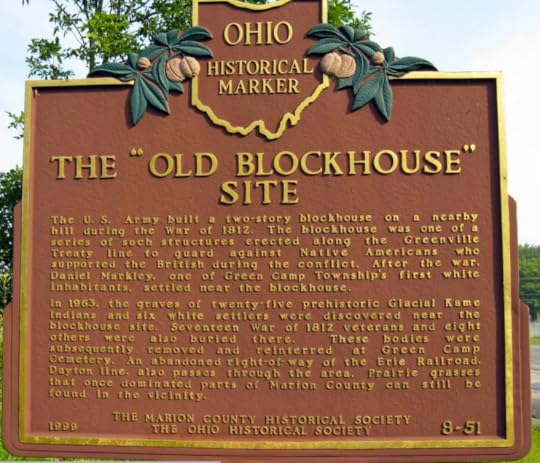Allison Bruning's Blog, page 23
May 16, 2014
#LiteraryBlessings: I'm on my way!

Happy Friday!
This week has been a week of changes for me. As with any of life's changes, I have had a hard time adjusting. I have always done the best when I am on a strict routine and when changes occur it throws me for a loop. I've been getting better at accepting change in my life. The changes that occurred this week are for the best and I wouldn't have it any other way.
Last weekend I was accepted by a literary manager. I have always dreamed of having my books with a Big 6 company and my stories on the big screen, television, games, and in comics. I learned at Full Sail that if I wanted a successful career as a writer I needed to build a great team to surround that included a manager, agent and entertainment lawyer. I was also taught the first person you want to seek out is a literary manager. The manager finds the agent and the attorney for you. I took the lesson to heart and began my search.
My small blessing this week are the changes that have occurred since Craig Michael Lewis became my manager. As many of you know I own Mountain Springs House. Craig immediately took control of my company so I could have more time to devote to my writing. He combined Mountain Springs House and our graphics company, Mountain Springs Graphics together then made some major changes to the company. These changes are for the best. The best part of having a manager has been the new found freedom that I have. Craig's interest are in my best interest. He not only runs my company now but also manages my writing career. I love having someone who can guide my wayward literary thoughts into something productive. I love that I don't have to worry about handling the business side of my writing. I'm still involved in my writing career. I still market my books but with Craig by my side I am able to reach farther with my literary projects.
God sent me an angel this weekend and I can just be me. What a blessing!
Published on May 16, 2014 06:28
May 15, 2014
Where In the World is Green Camp, Ohio? #OhioHistory
 This week I decided to merge my first Shawnee History post with my Marion, Ohio post because I want to tell you about an important Native American site in Marion County, Ohio. Green Camp.
This week I decided to merge my first Shawnee History post with my Marion, Ohio post because I want to tell you about an important Native American site in Marion County, Ohio. Green Camp.Most of you have probably never heard of Green Camp, Ohio. This small village with a population of 374 people plays a significant role in my new book, Field of Grace.
Green Camp was established as a village in 1838 where the Little Scioto and Scioto Rivers merge. (The Scioto River has played a significant role in Ohio history. We will cover more about the Scioto River in a future blog posting.) Marion County, Ohio is divided into fifteen townships. Green Camp lies in the Green Camp Township and is the only Green Camp Township in Ohio. Green Camp Township borders the following Marion County Townships:
Big Island Township - northMarion Township - northeastPleasant Township - eastProspect Township - southeastJackson Township, Union County - southwestBowling Green Township - west Most native Marion County residents will refer to a township such as "Over in Green Camp....,"Out towards Pleasant...." She lives in "Prospect....." You rarely use the name township. All of the townships are located relatively close to county seat, Marion. Green Camp is 6.2 miles from Marion.
Although Green Camp was established in 1838, it has a long history of human occupation. The oldest known human occupancy was sometime during 8000 BC to 1000 BC. Twenty-five graves of the Glacial Kame Culture were discovered close to Green Camp in 1963. The site, known as The Old Blockhouse Site, also contained the remains of six white settlers, seventeen War of 1812 Veterans and eight others.
 The Old Blockhouse Site
The Old Blockhouse Sitehttp://bit.ly/1k5ttDd
By: Charles CarperThe Old Blockhouse Site was given its name because it is the site of a blockhouse that was built during the War of 1812. A blockhouse is a small, isolated fort built to serve as a defensive unit. The blockhouse in Green Camp had been established to protect settlers and defend the Treaty of Greenville Line.
The Treaty of Greenville had been signed by various Ohio Tribes and Anthony Wayne after he defeated the Blue Jacket at the battle of Fallen Timbers. Several tribes who lived in the western Ohio region realized they could not win a war against the settlers and sued for peace. Wayne met with the tribal leaders of the Shawnee, Delaware, Wyandot, Ottawa, Miami, Eel River, Wea, Chippewa, Potawatomi, Kickapoo Indians, Piankashaw Indians, and the Kaskaskia at Fort Greenville. The tribal leaders and Wayne negotiated for eight months.
According to Ohio History Central, "The natives agreed to relinquish all claims to land south and east of a boundary that began roughly at the mouth of the Cuyahoga River. It ran southward to Fort Laurens and then turned westward to Fort Loramie and Fort Recovery. It then turned southward to the Ohio River. The Indians, however, could still hunt on the land that they ceded. The whites agreed to relinquish their claims to land north and west of the line, although the natives permitted the Americans to establish several trading posts in their territory. The United States also provided the Indians with $20,000 worth of goods for signing the treaty. The American government also agreed to give the natives $9,500 every year in goods. The Indians were to decide how the goods would be divided among them."
The settlers believed since the tribal leaders had signed the Treaty of Greenville that all of the members of the tribes would comply. They didn't understand that the nation was made up of several chiefs and a chief did not speak for his entire nation. Many tribes did not agree to the terms and continued to attack settlers in order to persuade them to leave Ohio forever.
Published on May 15, 2014 10:47
Important Changes for a New Day
 You may have noticed that I never posted on Tuesday. Normally you would have seen a posting about Irish History. Well this week my manager and I have made some changes to my blog. I am currently writing the screenplay adaption of my novel, Calico.
You may have noticed that I never posted on Tuesday. Normally you would have seen a posting about Irish History. Well this week my manager and I have made some changes to my blog. I am currently writing the screenplay adaption of my novel, Calico.We have decided to drop my series on Irish History and pick up a series on Shawnee Culture and Ohio History in honor of my first book, Calico, heading towards the screen.
For now I leave you with Calico's book trailer.
I am still writing Field of Grace and will continue posting on WWI and Ohio History.
Published on May 15, 2014 05:42
#IndieLife: What is a #literary #manager?
 The Author's LifeIt's been a very busy week for me and I am a day behind in my Indie Life post for this week.
The Author's LifeIt's been a very busy week for me and I am a day behind in my Indie Life post for this week.This week I want to explain why every writer needs a literary manager. I have worked in the Indie field for close to seven years. I have always had one goal in mind.....use the Indie field to launch and build my writing career. Last weekend, I was picked up by a literary manager. Having a manager doesn't mean that I have left the Indie World. It just means I have more freedom to work on my writing.
The market is full of great books and it can be a daunting task to market a break away sensation. Most authors who handle their own marketing have a hard time finding the enough time to write their next novel because the majority of their time is spent on marketing. If you are serious about your writing career then you want to build a team of trusted professionals that you can work with. The first person you want on your team is a literary manager.
A literary manager is a professional who handles the business side of your writing career. The
 symbiotic relationship between the literary manager and the author is as sacred as an author and their editor. The literary manager needs their author to produce works because they are only paid when the author's works sell. The author needs the literary manager to handle the day in and day out demands of a writer's career so he or she has more time to write. One of the great things about having a literary manager is that they bring to the table a wide range of resources that will open doors for your book. For example, two of the resources my manager brought with him a book tour specialist to schedule my book tours and a virtual personal assistant to handle all my emails.
symbiotic relationship between the literary manager and the author is as sacred as an author and their editor. The literary manager needs their author to produce works because they are only paid when the author's works sell. The author needs the literary manager to handle the day in and day out demands of a writer's career so he or she has more time to write. One of the great things about having a literary manager is that they bring to the table a wide range of resources that will open doors for your book. For example, two of the resources my manager brought with him a book tour specialist to schedule my book tours and a virtual personal assistant to handle all my emails.The literary manager isn't just for a novelist, either. Screenwriters, scriptwriters, game writers, and graphic novelists use literary managers as well. This is great for writers, like me, who write in different literary forms. I'm a screenwriter, novelist, scriptwriter, game writer, and graphics novelist. Like most writers, I have so many ideas that I can easily become sidetracked trying to create all of them at the same time. This is the point where your literary manager steps in and saves the writer's day. They will listen to your ideas and guide you as to which one needs to be developed first.
You should be careful in choosing who you want as your literary manager and never pay for a manager. They make money when you do. If they are asking for money up front then it's a scam.
You want a manager whom you can have a great working relationship with. Remember, your literary manager is your new best friend and will be with you for the long haul. Finding the right literary manager may take awhile but it's worth it.
Published on May 15, 2014 05:17
May 13, 2014
#ExpressYourself: The Character that Reflects Me the Most #IamWriting #NativeAmerican

Welcome back to my blog! Today I am asked to pick one fictional character who I think reflects my personality. Of all the characters I have ever penned I would have to say the one that reflects me the most is Calico.

Calico is the main character in my Children of the Shawnee series. The first book of the series, Calico, was the first book I ever wrote. I'm currently working on the screenplay for it.
Calico is a young woman raised in a culture that isn't her own. Orphaned at the age of eight, she is raised by her French uncle and Shawnee wife. Her twin sister, Rose, choses to leave the village and is raised in the French courts. Calico has abandonment issues because she was so close to her father and she never got to say goodbye to him before he died. She's naive, headstrong and compassionate. She can become so headstrong that once she makes a decision there is almost nothing that will deter her from maintaining her viewpoint, no matter how wrong it may be. Calico loves and lives hard, though. She's a great leader who loves her people, dearly.

Published on May 13, 2014 03:40
May 9, 2014
Moving #Blessings

Happy Friday!
Tomorrow will mark the one week anniversary since my husband and I moved into our apartment. My small blessing for this week is the fact that I only have a few boxes left. My office is starting to look like a well organized office. I still have some organizing to do.
What has your blessing been this week?
Published on May 09, 2014 03:50
May 8, 2014
Inspirational Marion, Ohio: #Faith, #Love, and #Grace in Central Ohio
Inspirational Marion, Ohio
Marion, Ohio. Most people from Ohio and the surrounding states have heard of my hometown. My family roots lie deep in this central Ohio city. If you have read my book, Elsa, then you are probably somewhat familiar with the city. Elsa, is loosely based on my the life of my great grandmother, Elva Beatrice (Russell) Messenger. It's a powerful book that takes you into the life of a woman who has given her heart to a man with Aspergers Syndrome in a time before the world knew what Aspergers was.
I am currently writing another historical fiction book that takes place in Marion, Ohio. Like Elsa, Field of Grace is loosely based on a true story that happened in my family. Field of Grace is the story of a young Appalachian Irish woman who must save her family from a local farmer who poisons her entire family. It's a fast paced, action adventure, historical fiction story that was inspired by a short story I had written for a Flash Fiction Contest. My story took third place. I later turned the short story into a screenplay for my graduate project at Full Sail University. Now I'm converting the screenplay into a the novel.
Field of Grace takes place in 1919. World War I has just drawn to a close and the war has changed everything. I will be presenting topics ever Thursday about Marion, Ohio, WWI, Salvation Army, Farming, and the culture of the time. I look forward to seeing you again next week.
Marion, Ohio. Most people from Ohio and the surrounding states have heard of my hometown. My family roots lie deep in this central Ohio city. If you have read my book, Elsa, then you are probably somewhat familiar with the city. Elsa, is loosely based on my the life of my great grandmother, Elva Beatrice (Russell) Messenger. It's a powerful book that takes you into the life of a woman who has given her heart to a man with Aspergers Syndrome in a time before the world knew what Aspergers was.

I am currently writing another historical fiction book that takes place in Marion, Ohio. Like Elsa, Field of Grace is loosely based on a true story that happened in my family. Field of Grace is the story of a young Appalachian Irish woman who must save her family from a local farmer who poisons her entire family. It's a fast paced, action adventure, historical fiction story that was inspired by a short story I had written for a Flash Fiction Contest. My story took third place. I later turned the short story into a screenplay for my graduate project at Full Sail University. Now I'm converting the screenplay into a the novel.
Field of Grace takes place in 1919. World War I has just drawn to a close and the war has changed everything. I will be presenting topics ever Thursday about Marion, Ohio, WWI, Salvation Army, Farming, and the culture of the time. I look forward to seeing you again next week.
Published on May 08, 2014 09:35
#ISWG: Missing #Royalties? Don't Blame the #Publisher.

Welcome back to the Insecure Writer's Support Group blog hop. Today I want to talk about sales. Many times an author will believe they have made X amount of sales because people will tell them that they have bought their book but when the reports come in from Amazon it shows a different number. Most of the time it's a lessor amount than the author was expecting. As a publisher and an author, I have experienced this phenomena many times.
Publisher - If you are with a publishing house then the only sales reports you get are from them. I want to lay aside a common misconception about publishers. Publishers are not responsible for your book's sales numbers. The publisher receives sales numbers and royalties from the distributor. Most of the time this distributor is Amazon because Amazon is such a powerhouse in the publishing world. Sad fact is even if a publisher or author doesn't like Amazon we are forced to deal with them because that's where most people are buying books.
Amazon gives the publisher a monthly report of sales and royalties at the end of each month. But the numbers being reported are a month behind. The publisher then has to put the data into a spreadsheet. Once it's in a spreadsheet they can send the data to the author along with the author's cut of the royalties.
Author - You can track your sales ,just as a publisher would, through Createspace and Amazon. It's harder to track your sales on Smashwords because Smashwords doesn't give monthly reports. If you find any discrepancies with your reports you can challenge the distributor.
CHALLENGE THE DISTRIBUTORS? Before you let your emotions get the best of you and you go off charging allegations of fraud at Amazon, Smashwords, etc. you need to understand that many people will say they have bought your book only to appease you as an author. It's a sad fact but a reality in this business. Yet Amazon is infamous for under reporting sales as well. I haven't had much of problem with this on Smashwords but I have known several authors who have had issues with Amazon.
So how do you challenge the great and mighty Amazon?
There are two ways of doing this.
Ebook - If you know the person has bought a copy of your ebook but it hasn't been reported by Amazon ask the person to send you the order# found on their receipt. Every time someone orders an ebook Amazon will give them an order #. Once you have that order # you can email KDP (they do not have phones) with the order # and challenge the report. If Kindle finds they never reported the sale to you they will correct their records and release the royalty due to you the following month.
Print Book - If you know the person who has bought the print book and the sale hasn't been recorded then ask the person to take a photo of the bar code found inside the back cover. The bar code should say the city and date in which the book was printed. Once you have that you can call Createspace, give then the bar code and challenge the sales report. Like Kindle, if they find the sale was not recorded they will fix their records and release the royalties due the following month. I have had this happen on more than one occasion and have always received my missing royalties.
Published on May 08, 2014 05:47
May 6, 2014
#Ireland #History and #Myths: Neolithic Irish Create Ceide Fields
Welcome back to my series on Ireland's History and Myths. Ireland entered the Neolithic Age between 3900 to 3000 BC when English invaders brought farming to Ireland. One of the first places in Neolithic Ireland to have been farmed is known as Céide Fields. Dated to around 3500 BC, it is considered to be the world's oldest Neolithic site.
Céide Fields is located in Northern Ireland on the cliffs in Mayo County overlooking the Atlantic Ocean. It was discovered during the 1930's when schoolteacher Patrick Caulfield was cutting into the turf to access the peat for fuel. He noticed a pile of uncovered rocks neatly stacked underneath the peat. The school teacher concluded that the stones must have been deliberately placed there by ancient humans due to the their location and their placement.
Forty years later, his son, Dr. Seamus Caulfield, took an interest in the bogs and the stones. Dr. Caulfield surveyed all of the bogs on his family's land and discovered underneath the peat bogs on his father's land laid a stone wall, houses and Mesolithic tombs.
The land had once been home to a thick forest that had laid a thick root system across the land. According to the Irish American Post:
Céide’s farmers cleared the forests from this land for planting, using the timber to build their houses. But this loss of the trees eventually changed the environment. The trees, whose absorbing roots had gradually released rainfall to canopy evaporation, were no longer there. Céide’s annual 240 days of rain left the cleared landscape moister and moister. Nutrients leached away. Plants now held onto their moisture. Cycles of life, death, and decay to the soil were disrupted. Mosses and other plants which thrived on poor soils expanded their range, forming bogland. Over several centuries the farmers were forced out by poor soil, overabundant moisture, and an ever-expanding peat bog – what’s been called a "slow motion Pompeii." This peat bog, however, preserved Céide as an unspoiled archeological site."
Dr. Seamus Caulfield extensively studied the peat bogs of his family's farm using the method shown in this video.
In 1989, Dr. Caulfield wanted to preserve the archeological research he discovered and draw tourist to the area. With the help of Prof. Martin Downes along with a local committee, he created the Center at Céide. The Center was used to house all of the site's research. In 1993, he opened the Céide Fields Interpretive Center. The award winning interpretive center is easily distinguished by its pyramid shape and was opened by the Office of Public Works.
Céide Fields is located in Northern Ireland on the cliffs in Mayo County overlooking the Atlantic Ocean. It was discovered during the 1930's when schoolteacher Patrick Caulfield was cutting into the turf to access the peat for fuel. He noticed a pile of uncovered rocks neatly stacked underneath the peat. The school teacher concluded that the stones must have been deliberately placed there by ancient humans due to the their location and their placement.
Forty years later, his son, Dr. Seamus Caulfield, took an interest in the bogs and the stones. Dr. Caulfield surveyed all of the bogs on his family's land and discovered underneath the peat bogs on his father's land laid a stone wall, houses and Mesolithic tombs.
The land had once been home to a thick forest that had laid a thick root system across the land. According to the Irish American Post:
Céide’s farmers cleared the forests from this land for planting, using the timber to build their houses. But this loss of the trees eventually changed the environment. The trees, whose absorbing roots had gradually released rainfall to canopy evaporation, were no longer there. Céide’s annual 240 days of rain left the cleared landscape moister and moister. Nutrients leached away. Plants now held onto their moisture. Cycles of life, death, and decay to the soil were disrupted. Mosses and other plants which thrived on poor soils expanded their range, forming bogland. Over several centuries the farmers were forced out by poor soil, overabundant moisture, and an ever-expanding peat bog – what’s been called a "slow motion Pompeii." This peat bog, however, preserved Céide as an unspoiled archeological site."
Dr. Seamus Caulfield extensively studied the peat bogs of his family's farm using the method shown in this video.
In 1989, Dr. Caulfield wanted to preserve the archeological research he discovered and draw tourist to the area. With the help of Prof. Martin Downes along with a local committee, he created the Center at Céide. The Center was used to house all of the site's research. In 1993, he opened the Céide Fields Interpretive Center. The award winning interpretive center is easily distinguished by its pyramid shape and was opened by the Office of Public Works.
Published on May 06, 2014 09:45
#ExpressYourself: #Family Research Leads to #Bestselling #Historical Fiction Novel

I'm so grateful to see the return of the Express Yourself Blog Hop. The Express Yourself Blog Hop had taken last month off but is now back in full swing.
This week I was asked to choose one of my favorite books. I decided to think about all the books I had written and chose one from there. I chose Elsa.
Elsa (The Secret Heritage Series: Book 1) is very near and dear to my heart because it's based on my great grandmother's life, Elva Beatrice (Russell) Messenger. My grandfather knew very little about his grandmother Elva Messenger because his mother had died in a kerosene fire when he was a toddler. He had been raised by his father. In fact, we had never heard of Elva Messenger until I was came across her in my genealogical research years after my grandfather had passed. The more I researched into her life the more I wanted to write about it. Grandma Elva was an amazing woman.
I was reunited with my uncle and aunt while I was writing Elsa. My Grandpa Freeland (Franklin) never had Aspergers, that I know of. My Uncle Jeff, the son of my grandfather, has Aspergers. He's been married to my aunt for over thirty years. The relationship between Uncle Jeff and Aunt Kate is so inspiring I wanted to share it with the world. Most of what people hear about Aspergers is about children not adults. I wanted my readers to see the world through the eyes of an adult with Aspergers Syndrome.
The Secret Heritage series will trace the life of Elsa and how Franklin's Aspergers Syndrome affects her and their children's lives. NOTE: Aspergers Syndrome was not discovered until the 1940's. The series begins in 1909 and will end in 1943.

http://amzn.to/GADXKE
The Express Yourself Blog Hop asks me to turn to page 89 and then share the 8th and 9the sentences. Here it goes.
Elsa speaking to Juliette (Franklin's mother) "Deborah and I have been close since my birth."
Juliette: "I'm surprised to hear that."
Published on May 06, 2014 04:26



